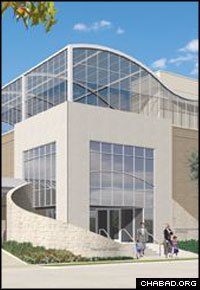In the largest of the 48 contiguous states, thinking big is a way of life. So it comes as no surprise that when the opportunity arose to make the Chabad-Lubavitch Center of Houston bigger and better, the local Jewish community was ready and willing to chip in.
The same can be said in the city’s Uptown District, where Chabad of Uptown just moved into temporary quarters after outgrowing its previous home.
Dr. Irv Fishman, whose daughters-in-law teach at the Torah Day School at the Chabad-Lubavitch Center, says that he’s particularly excited about the center’s expansion, in which a new west wing will accommodate eight new classrooms, two Jewish ritual baths, a larger synagogue, social hall, kitchen and library.
“We’ve been involved in the school for 30 years,” says Fishman, 62, of his family. “Our oldest child was one of the first students in the school.
“We consider it an extension of our home,” he adds. “Please G‑d, our great-grandchildren will be there too.”
As part of the project – which will see the current 15,000-sqare-foot building mushroom to 40,000-square-feet of usable space – the Chabad-Lubavitch Center, directed by Rabbi Shimon Lazaroff, purchased two acres of land adjacent to its current structure. The acquisition will provide a new playing field, state-of-the-art playground and parking lot. A July 13 dedication ceremony will feature a Chinese Auction, rooftop party and concert.
“After we’re finished dedicating, we’ll start renovating the old classrooms and build the women’s mikvah,” says Lazaroff. “Then, it will be complete.
“The center is a three-acre campus right in the heart of Houston’s Jewish community,” adds the rabbi, who moved to the city in 1972 with wife Chiena Lazaroff – director of the day school – and four young children.
The Lazaroffs’ Chabad House, which also serves as the Texas Regional Headquarters of Chabad-Lubavitch, was one of 71 new centers established that year in honor of the 70th birthday of the Rebbe, Rabbi Menachem Mendel Schneerson, of righteous memory.
The current women’s mikvah will be converted to men’s use. Chiena Lazaroff says that the new mikvah will boast three preparation rooms with “marble, granite, and the latest in fixtures and lighting.”
“It’s going to be stunning,” adds Lazaroff, who expects more than 200 women to regularly use the ritual bath.
Moving on Up in Uptown

While his parents oversee the expansion’s final touches, Rabbi Chaim Lazaroff has plans of his own to implement after Chabad of Uptown’s recent move.
“Our old shul couldn’t handle more than a minyan,” says the younger Lazaroff, one of three sons who serve as Chabad-Lubavitch emissaries in Texas. “Now, there’s ample space.”
“It seemed like a necessary move,” offers Dr. Jerry Simmons. “It keeps things going.”
Simmons, a neurologist, has been attending Chabad of Uptown’s Thursday afternoon lunch-and-learn Torah classes for the past two years.
The class provides “good insight,” he adds.
Seventh-generation Texan Bob Epstein says that he enjoyed the Shavuot services held at the new location, a holdover until an even bigger center is readied for permanent occupancy.
“It was absolutely beautiful,” says Epstein, 85, “very relaxed, comfortable and clean. I enjoyed being there.”
“The fact that we found it is a miracle,” says Lazaroff, who runs the Chabad House with wife Chanie Lazaroff.
One advantage to the new Uptown space is the ability to accommodate worshippers for High Holiday services. In the past, the Lazaroffs had to rent out local halls. The rabbi says, however, that the planned permanent location – to be located among the city’s high-rises – will be even bigger.
“We’ll be able to provide a greater amount of classes and holiday programs,” he says.
For his part, Shimon Lazaroff looks across the Houston landscape with a little bit of wonder.
“When I came here, there were only three Sabbath-observant Jews in the city,” he says. “Now there’s 400. And the community just keeps growing and growing.”




Start a Discussion